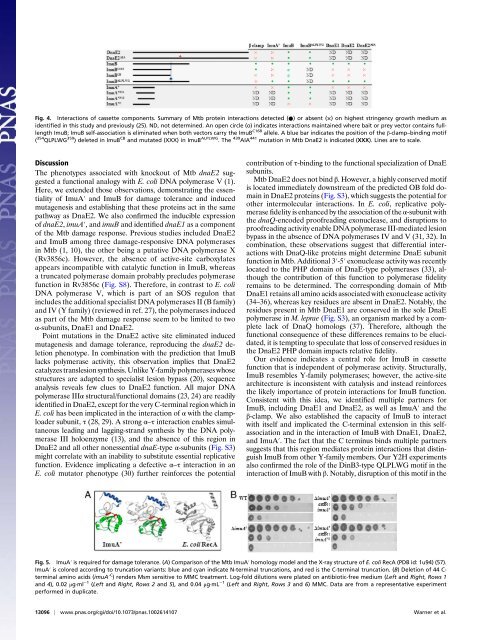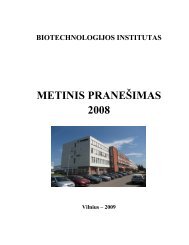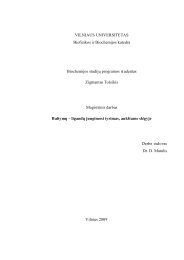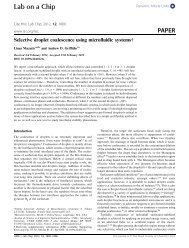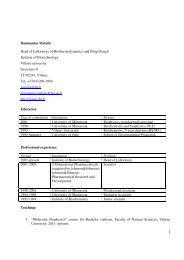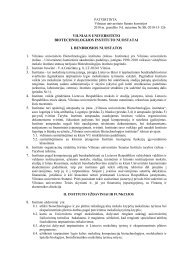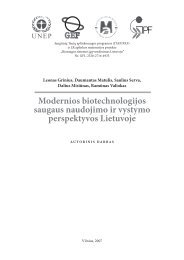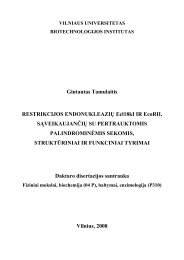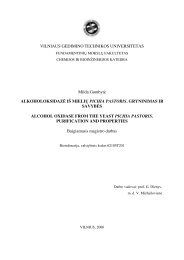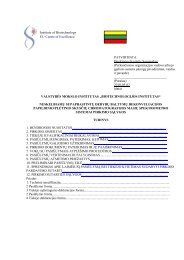Essential roles for imuA â²- and imuB-encoded accessory factors in ...
Essential roles for imuA â²- and imuB-encoded accessory factors in ...
Essential roles for imuA â²- and imuB-encoded accessory factors in ...
You also want an ePaper? Increase the reach of your titles
YUMPU automatically turns print PDFs into web optimized ePapers that Google loves.
Fig. 4. Interactions of cassette components. Summary of Mtb prote<strong>in</strong> <strong>in</strong>teractions detected (●) or absent (×) on highest str<strong>in</strong>gency growth medium as<br />
identified <strong>in</strong> this study <strong>and</strong> previously (25). ND, not determ<strong>in</strong>ed. An open circle (o) <strong>in</strong>dicates <strong>in</strong>teractions ma<strong>in</strong>ta<strong>in</strong>ed where bait or prey vector conta<strong>in</strong>s fulllength<br />
ImuB; ImuB self-association is elim<strong>in</strong>ated when both vectors carry the ImuB C168 allele. A blue bar <strong>in</strong>dicates the position of the β-clamp–b<strong>in</strong>d<strong>in</strong>g motif<br />
( 354 QLPLWG 359 ) deleted <strong>in</strong> ImuB CB <strong>and</strong> mutated (XXX) <strong>in</strong> ImuB ALPLWG . The 439 AIA 441 mutation <strong>in</strong> Mtb DnaE2 is <strong>in</strong>dicated (XXX). L<strong>in</strong>es are to scale.<br />
Discussion<br />
The phenotypes associated with knockout of Mtb dnaE2 suggested<br />
a functional analogy with E. coli DNA polymerase V (1).<br />
Here, we extended those observations, demonstrat<strong>in</strong>g the essentiality<br />
of ImuA′ <strong>and</strong> ImuB <strong>for</strong> damage tolerance <strong>and</strong> <strong>in</strong>duced<br />
mutagenesis <strong>and</strong> establish<strong>in</strong>g that these prote<strong>in</strong>s act <strong>in</strong> the same<br />
pathway as DnaE2. We also confirmed the <strong>in</strong>ducible expression<br />
of dnaE2, <strong>imuA</strong>′, <strong>and</strong> <strong>imuB</strong> <strong>and</strong> identified dnaE1 as a component<br />
of the Mtb damage response. Previous studies <strong>in</strong>cluded DnaE2<br />
<strong>and</strong> ImuB among three damage-responsive DNA polymerases<br />
<strong>in</strong> Mtb (1, 10), the other be<strong>in</strong>g a putative DNA polymerase X<br />
(Rv3856c). However, the absence of active-site carboxylates<br />
appears <strong>in</strong>compatible with catalytic function <strong>in</strong> ImuB, whereas<br />
a truncated polymerase doma<strong>in</strong> probably precludes polymerase<br />
function <strong>in</strong> Rv3856c (Fig. S8). There<strong>for</strong>e, <strong>in</strong> contrast to E. coli<br />
DNA polymerase V, which is part of an SOS regulon that<br />
<strong>in</strong>cludes the additional specialist DNA polymerases II (B family)<br />
<strong>and</strong> IV (Y family) (reviewed <strong>in</strong> ref. 27), the polymerases <strong>in</strong>duced<br />
as part of the Mtb damage response seem to be limited to two<br />
α-subunits, DnaE1 <strong>and</strong> DnaE2.<br />
Po<strong>in</strong>t mutations <strong>in</strong> the DnaE2 active site elim<strong>in</strong>ated <strong>in</strong>duced<br />
mutagenesis <strong>and</strong> damage tolerance, reproduc<strong>in</strong>g the dnaE2 deletion<br />
phenotype. In comb<strong>in</strong>ation with the prediction that ImuB<br />
lacks polymerase activity, this observation implies that DnaE2<br />
catalyzes translesion synthesis. Unlike Y-family polymerases whose<br />
structures are adapted to specialist lesion bypass (20), sequence<br />
analysis reveals few clues to DnaE2 function. All major DNA<br />
polymerase IIIα structural/functional doma<strong>in</strong>s (23, 24) are readily<br />
identified <strong>in</strong> DnaE2, except <strong>for</strong> the very C-term<strong>in</strong>al region which <strong>in</strong><br />
E. coli has been implicated <strong>in</strong> the <strong>in</strong>teraction of α with the clamploader<br />
subunit, τ (28, 29). A strong α–τ <strong>in</strong>teraction enables simultaneous<br />
lead<strong>in</strong>g <strong>and</strong> lagg<strong>in</strong>g-str<strong>and</strong> synthesis by the DNA polymerase<br />
III holoenzyme (13), <strong>and</strong> the absence of this region <strong>in</strong><br />
DnaE2 <strong>and</strong> all other nonessential dnaE-type α-subunits (Fig. S3)<br />
might correlate with an <strong>in</strong>ability to substitute essential replicative<br />
function. Evidence implicat<strong>in</strong>g a defective α–τ <strong>in</strong>teraction <strong>in</strong> an<br />
E. coli mutator phenotype (30) further re<strong>in</strong><strong>for</strong>ces the potential<br />
contribution of τ-b<strong>in</strong>d<strong>in</strong>g to the functional specialization of DnaE<br />
subunits.<br />
Mtb DnaE2 does not b<strong>in</strong>d β. However, a highly conserved motif<br />
is located immediately downstream of the predicted OB fold doma<strong>in</strong><br />
<strong>in</strong> DnaE2 prote<strong>in</strong>s (Fig. S3), which suggests the potential <strong>for</strong><br />
other <strong>in</strong>termolecular <strong>in</strong>teractions. In E. coli, replicative polymerase<br />
fidelity is enhanced by the association of the α-subunit with<br />
the dnaQ-<strong>encoded</strong> proofread<strong>in</strong>g exonuclease, <strong>and</strong> disruptions to<br />
proofread<strong>in</strong>g activity enable DNA polymerase III-mediated lesion<br />
bypass <strong>in</strong> the absence of DNA polymerases IV <strong>and</strong> V (31, 32). In<br />
comb<strong>in</strong>ation, these observations suggest that differential <strong>in</strong>teractions<br />
with DnaQ-like prote<strong>in</strong>s might determ<strong>in</strong>e DnaE subunit<br />
function <strong>in</strong> Mtb. Additional 3′-5′ exonuclease activity was recently<br />
located to the PHP doma<strong>in</strong> of DnaE-type polymerases (33), although<br />
the contribution of this function to polymerase fidelity<br />
rema<strong>in</strong>s to be determ<strong>in</strong>ed. The correspond<strong>in</strong>g doma<strong>in</strong> of Mtb<br />
DnaE1 reta<strong>in</strong>s all am<strong>in</strong>o acids associated with exonuclease activity<br />
(34–36), whereas key residues are absent <strong>in</strong> DnaE2. Notably, the<br />
residues present <strong>in</strong> Mtb DnaE1 are conserved <strong>in</strong> the sole DnaE<br />
polymerase <strong>in</strong> M. leprae (Fig. S3), an organism marked by a complete<br />
lack of DnaQ homologs (37). There<strong>for</strong>e, although the<br />
functional consequence of these differences rema<strong>in</strong>s to be elucidated,<br />
it is tempt<strong>in</strong>g to speculate that loss of conserved residues <strong>in</strong><br />
the DnaE2 PHP doma<strong>in</strong> impacts relative fidelity.<br />
Our evidence <strong>in</strong>dicates a central role <strong>for</strong> ImuB <strong>in</strong> cassette<br />
function that is <strong>in</strong>dependent of polymerase activity. Structurally,<br />
ImuB resembles Y-family polymerases; however, the active-site<br />
architecture is <strong>in</strong>consistent with catalysis <strong>and</strong> <strong>in</strong>stead re<strong>in</strong><strong>for</strong>ces<br />
the likely importance of prote<strong>in</strong> <strong>in</strong>teractions <strong>for</strong> ImuB function.<br />
Consistent with this idea, we identified multiple partners <strong>for</strong><br />
ImuB, <strong>in</strong>clud<strong>in</strong>g DnaE1 <strong>and</strong> DnaE2, as well as ImuA′ <strong>and</strong> the<br />
β-clamp. We also established the capacity of ImuB to <strong>in</strong>teract<br />
with itself <strong>and</strong> implicated the C-term<strong>in</strong>al extension <strong>in</strong> this selfassociation<br />
<strong>and</strong> <strong>in</strong> the <strong>in</strong>teraction of ImuB with DnaE1, DnaE2,<br />
<strong>and</strong> ImuA′. The fact that the C term<strong>in</strong>us b<strong>in</strong>ds multiple partners<br />
suggests that this region mediates prote<strong>in</strong> <strong>in</strong>teractions that dist<strong>in</strong>guish<br />
ImuB from other Y-family members. Our Y2H experiments<br />
also confirmed the role of the D<strong>in</strong>B3-type QLPLWG motif <strong>in</strong> the<br />
<strong>in</strong>teraction of ImuB with β. Notably, disruption of this motif <strong>in</strong> the<br />
Fig. 5. ImuA′ is required <strong>for</strong> damage tolerance. (A) Comparison of the Mtb ImuA′ homology model <strong>and</strong> the X-ray structure of E. coli RecA (PDB id: 1u94) (57).<br />
ImuA′ is colored accord<strong>in</strong>g to truncation variants: blue <strong>and</strong> cyan <strong>in</strong>dicate N-term<strong>in</strong>al truncations, <strong>and</strong> red is the C-term<strong>in</strong>al truncation. (B) Deletion of 44 C-<br />
term<strong>in</strong>al am<strong>in</strong>o acids (<strong>imuA</strong>′ C ) renders Msm sensitive to MMC treatment. Log-fold dilutions were plated on antibiotic-free medium (Left <strong>and</strong> Right, Rows 1<br />
<strong>and</strong> 4), 0.02 μg·ml −1 (Left <strong>and</strong> Right, Rows 2 <strong>and</strong> 5), <strong>and</strong> 0.04 μg·mL −1 (Left <strong>and</strong> Right, Rows 3 <strong>and</strong> 6) MMC. Data are from a representative experiment<br />
per<strong>for</strong>med <strong>in</strong> duplicate.<br />
13096 | www.pnas.org/cgi/doi/10.1073/pnas.1002614107 Warner et al.


